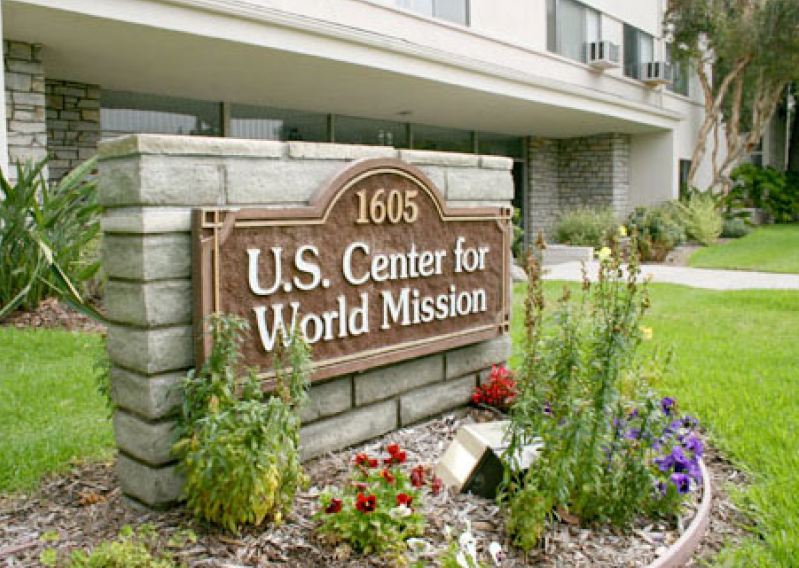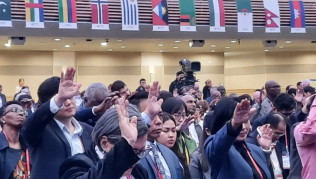
This is part of a series of articles about the life and ideas of Dr. Ralph D. Winter, whose memorial service will be held this Sunday, June 28. Winter, the co-founder the U.S. Center for World Mission, passed away on May 20, 2009, after a long battle with cancer. He was 84.
PASADENA Calif. – Dr. Ralph D. Winter, his wife Roberta, and his secretary Prudence had only about $100 in cash when they placed a bid for the $15 million campus of Pasadena College in California in 1976.
The educational institution of the Church of the Nazarene, which had recently been renamed to Point Loma College, was trying to sell the campus after having purchased a new and larger campus in San Diego three years earlier, in 1973.
But already on the campus was a cult known as Church Universal and Triumphant (Summit Lighthouse), whose members revere a mixture of “ascended masters” including Buddha, Krishna, and Jesus. Although they claim to be Christians, the members do not believe Jesus died on the cross for their sins. Moreover, they believe a person may experience multiple rebirths through reincarnation until their soul reaches a state of perfection and becomes one with the Universal Soul or “God.”
Summit was renting space on the main campus when Winter offered to buy it. When the cult’s leaders heard that someone wanted to buy the campus, they also offered to purchase it with the millions they had on hand.
Winter, on the other hand, had no salary and no staff after quitting his tenured teaching position at Fuller Theological Seminary in order to focus full-time on establishing the U.S. Center for World Mission (USCWM). Moreover, he had four unmarried daughters with two of them still needing to go through college back home.
Despite all the reasons he had not to create the think-tank for world missions, Winter had the “conviction” that God expected him to do something to help reach the 2.5 billion hidden (or unreached) people at the time, Roberta recalled in I Will Do A New Thing, the book she had written prior to her death in 2001.
“I must admit,” Dr. Winter told other professors, according to Roberta, “that this project may very well fail. But I am overwhelmingly convinced that God wants someone to try it. No one else seems willing, so I guess I’ll have to.”
Inspiration behind USCWM
Two years earlier, in 1974, Winter had delivered a groundbreaking presentation at the Lausanne Congress for World Evangelization, where he introduced the term “unreached people groups” and used statistics to show that over two billion people still could not hear the Gospel in their own language and cultural setting.
At the time, many Christians had begun to assume that the work of missions was over as the Gospel had gone to every continent and nearly every country. But, as Winter showed in a paper circulated prior to the Lausanne conference, even if every Christian in the world shared the Gospel with their neighbors, only half the world would hear it.
“The awesome problem,” he wrote “is ... that most non-Christians in the world today are not culturally near neighbors of any Christians.”
To reach them, Winter added, will take “a special kind of ‘cross-cultural’ evangelism.”
After returning to America from the conference, Winter tried to get Fuller Seminary and other mission leaders involved in setting up a world missions think-tank, but people felt the plan was too big and risky. No one except his wife and secretary joined him in the challenge.
“Ralph knew he could not possibly found such a center on his own. But there was no way around it,” Roberta wrote. “Whether he found someone to help or not, he had to move, even if it meant sacrificing his own plans and security and leaving a job he loved.”
Battle with the cult
After making a bid for the Pasadena campus of Point Loma College in 1976, Winter and his small team found themselves having to battle the Summit cult to get Point Loma officials to permit him to purchase the campus. Point Loma was in desperate need of money to fund its new campus and Winter had no money.
Linda Dorr, Winter’s third daughter, recalled to The Christian Post on Monday that one of greatest miracles that occurred during the process to obtain the campus was getting Point Loma to agree to give USCWM a legal option to buy when Winter and his team offered such a small amount of money.
Usually for a property that size, at least $150,000 would be offered to hold the campus.
Winter offered $15,000.
And Point Loma officials accepted that.
As Roberta explained in her book, the officials, all Christians, were deeply troubled over the presence of the Summit on campus.
During their time on the campus, Summit members would chant and meditate in front of a giant Buddha statue. A former high-level Summit leader also revealed to USCWM that top Summit leader had the ability to read other people’s mind and could, to a certain extent, control people’s thought process. And Summit’s highest leader claimed that she was able to communicate with her dead husband.
USCWM members later found out that Summit members had chanted against them during an especially difficult time during their quest to acquire the campus. After their discovery, staff members devoted more time to praying for the campus and for spiritual protection.
Roberta said that before their encounter with Summit, many USCWM members had not taken the occult seriously. But after their experience, they all understood it was a spiritual battle.
Battle over finances
Over the next decade, USCWM struggled to pay for the newly acquired campus – first having to make the $1.5 million down payment, then the $175,000 mortgage payments, and lastly the $6.5 million balloon payment.
Nearly every payment was gathered at the last minute. Roberta recalled that a day before the first installment of the down payment was due, they still lacked $400,000 of the $850,000 needed.
“It had been a constant struggle to make our mortgage payments of $175,000 every three months for five years,” recalled Roberta. “We had fallen behind several times, once almost to the point of foreclosure.”
As part of the effort to fund the campus, Winter persuaded thousands to give “the last thousand,” as former student and now prominent pastor John Piper recalled last month.
Piper, who had Winter as a professor during his time at Fuller Seminary, said he “couldn’t resist the vision.”
“His vision of the advance of the gospel was breathtaking,” Piper recalled in his blog one day after Winter’s death on May 20, 2009.
“I think I sent $2,000.”
Despite the pressure to raise funds for the campus, Winter was determined from the start to not forget what the campus was for. While some wanted to focus on fundraising, Winter would say, “I don’t think He (God) will [give it to us] unless we show that His concerns come first.”
We must do all we can to help make missions a top priority again,” Roberta recalled him saying.
Roberta later admitted how many of the center’s members, deep inside, “had become tired of having to trust the Lord.”
“We were tired of not knowing until the last minute if we would go under or not,” she recalled.
This was true especially in times like September 1983, when the center needed to pay the $6.5 million balloon payment and only had one million six weeks beforehand.
“But the Lord had miraculously brought us through again and again,” testified Roberta.
And by January 1988, the campus and surrounding houses were all paid off.
Retrospect
Reflecting on the long and difficult journey traveled in establishing USCWM, Dr. Winter’s daughters said the hardest part for their parents was probably having to endure the “naysayers.”
“I think the hardest thing were the naysayers – people who predicted it would fail,” Becky Lewis, Dr. Winter’s second daughter, told The Christian Post. “People would sometimes even question his motives and accuse him of being unreasonable or trying to make a name for himself.
“I think that has been the most hurtful – the questioning of their motives,” Lewis said. “He was just trying to get the job done and it was like ‘No one else would do it, so I’ve got to do it myself.’”
Dr. Winter – who had a degree in engineering from Caltech as well as degrees in anthropology, linguistics and theology – called himself a “Christian social engineer.” He explained that he “looks for the gaps in the social structure of the Christian cause and tries to fill them.”
To this day, after more than 30 years, USCWM remains a place where mission agencies can work together to strategize, research and promote ideas to help complete the unfinished task of reaching every people group with the Gospel. Some have called USCWM the “missions Pentagon” because it is where mission research, mission mobilization, and mission training take place simultaneously.
When the Center was founded in 1976, there were an estimated 17,000 distinct people groups worldwide that had not been targeted for evangelism. Today, 7,000 unreached people groups remain in the world.
Winter, who also founded and served several institutions and organizations, including William Carey International University, is widely regarded today as one of the key factors behind the major shift of perspective in the mission movement – a shift from going to countries and individuals to penetrating “unreached peoples,” or those who have been bypassed.
He was named by Time magazine in 2005 as one of America’s 25 most influential Evangelicals and received the Lifetime of Service Award last year at the North American Mission Leaders Conference, a major annual mission gathering co-sponsored by The Mission Exchange and CrossGlobal Link.
Winter died on May 20,2009, at his home in Pasadena, Calif., after a long battle with cancer.
His memorial service will be held in the main sanctuary of Lake Avenue Congregation Church in Pasadena, Calif. on Sunday, June 28 at 3:00 p.m.
Winter is survived by his second wife, Barbara, four daughters, 14 grandchildren, and one great-granddaughter.
Christian Post reporter Eric Young contributed to this article.







